Smart City Ontology Framework for Urban Data Integration and Application
Abstract
Highlights
- A hierarchical ontology (SMOF) with universal and extended properties and a concise relation scheme that draws on authoritative standards/ontologies (e.g., IFC, CityGML, SSN/SOSA) to support city-wide, cross-domain data integration.
- Combined quantitative analyses, LLM as judge assessment, expert evaluation, and two empirical scenarios confirm SMOF’s structural soundness, conceptual richness, and capacity to integrate heterogeneous data for querying and reasoning.
- By harmonizing heterogeneous data and semantics, SMOF enables coordinated urban services ranging from emergency management to transportation and infrastructure.
- Its scalability and reusability provide a foundation for extending ontology-driven approaches to broader domains of smart city governance and decision-making.
Abstract
1. Introduction
2. Related Work
2.1. Integration and Application of Multi-Source Heterogeneous Urban Data
2.2. Ontology Construction for Multi-Source Urban Data
3. Ontology Framework Design
3.1. Overall Workflow
3.2. Specification and Knowledge Foundations
3.2.1. Competency Questions
3.2.2. Knowledge Sources
3.2.3. Modeling Principles
3.3. Core Entity Module Design
3.4. Attribute and Relation Design
3.5. Ontology Modeling and Mapping
4. Evaluation and Validation
4.1. Answers to the Competency Questions
4.2. Evaluation and Comparison
4.2.1. Objective Evaluation
4.2.2. Subjective Evaluation
4.3. Practical Scenario Application
5. Discussion
6. Conclusions
7. Patents
Author Contributions
Funding
Data Availability Statement
Acknowledgments
Conflicts of Interest
Appendix A
| Competency Question | Owl Format Answers |
|---|---|
| CQ1 | # Hierarchy (subClassOf) smof:Building_components rdfs:subClassOf smof:Building_infrastructure. # Intrinsic information (data property) smof:hasName a owl:DatatypeProperty; rdfs:domain:Entity; rdfs:range xsd:string. # Inter-entity relationship (object property) smof:adjacentTo a owl:ObjectProperty; rdfs:domain smof:SpatialEntity; rdfs:range smof:SpatialEntity. |
| CQ2 | # Top-level classes:SMOF smof:SMOF a owl:Class. smof:Building_infrastructure a owl:Class; rdfs:subClassOf smof:SMOF. smof:Events a owl:Class; rdfs:subClassOf smof:SMOF. smof:Geometry a owl:Class; rdfs:subClassOf smof:SMOF. smof:Nature_and_Geographic_Space a owl:Class; rdfs:subClassOf smof:SMOF. smof:Pipelines a owl:Class; rdfs:subClassOf smof:SMOF. smof:Population_and_Social_Organizations a owl:Class; rdfs:subClassOf smof:SMOF. smof:Special_Topic_Data a owl:Class; rdfs:subClassOf smof:SMOF. smof:Time a owl:Class; rdfs:subClassOf smof:SMOF. smof:Traffic a owl:Class; rdfs:subClassOf smof:SMOF. smof:Urban_Management_Components a owl:Class; rdfs:subClassOf smof:SMOF. |
| CQ3 | # Spatial-attribute super-class smof:spatial_attributes a owl:Class. # Address (semantic description) smof:Spatial_semantic_description a owl:DatatypeProperty; rdfs:subPropertyOf smof:spatial_attributes; rdfs:domain smof:SpatialEntity; rdfs:range xsd:string. # Absolute position (lat-lon) smof:AbsoluteSpatialPosition a owl:DatatypeProperty; rdfs:subPropertyOf smof:spatial_attributes; rdfs:domain smof:SpatialEntity; rdfs:range xsd:string. # Topological relations spatial:topological a owl:Class. smof:adjacentTo a owl:ObjectProperty; rdfs:subPropertyOf spatial:topological; rdfs:domain smof:SpatialEntity; rdfs:range smof:SpatialEntity. smof:connectsTo a owl:ObjectProperty; rdfs:subPropertyOf spatial:topological; rdfs:domain SpatialEntity; rdfs:range SpatialEntity. smof:ContainedIn a owl:ObjectProperty; rdfs:subPropertyOf spatial:topological; rdfs:domain SpatialEntity; rdfs:range SpatialEntity. smof:overlapsWith a owl:ObjectProperty; rdfs:subPropertyOf spatial:topological; rdfs:domain SpatialEntity; rdfs:range SpatialEntity. smof:Separation a owl:ObjectProperty; rdfs:subPropertyOf spatial:topological; rdfs:domain smof:SpatialEntity; rdfs:range smof:SpatialEntity. |
| CQ4 | # Alignment with KM4City smof:Administration a owl:Class; owl:equivalentClass km4c:Administration. smof:LocalPublicTransport a owl:Class; owl:equivalentClass km4c:Localpublictransport. smof:Sensors a owl:Class; owl:equivalentClass km4c:Sensors. # Alignment with UrbanKG smof:POIs a owl:Class; owl:equivalentClass ukg:POIs. smof:Users a owl:Class; owl:equivalentClass ukg:Users. smof:Satellite_Images a owl:Class; owl:equivalentClass ukg:Satellite images. smof:Street_View_Images a owl:Class; owl:equivalentClass ukg:Street view images. |
| CQ5 | # Alignment with CityGML smof:Geometry a owl:Class; owl:equivalentClass citygml:Geometry. smof:Building_Geometry a owl:Class; owl:equivalentClass citygml:Building. |
| CQ6 | # Alignment with SOSA smof:Sensor a owl:Class; owl:equivalentClass sosa:Sensor. smof:Observes a owl:ObjectProperty; owl:equivalentProperty sosa:observes. |
| CQ7 | # Dependency relations smof:Dependency a owl:Class. smof:Association a owl:ObjectProperty; rdfs:subPropertyOf smof:Dependency; rdfs:domain smof:Entity; rdfs:range smof:Entity. smof:Depended_on a owl:ObjectProperty; rdfs:subPropertyOf smof:Dependency; rdfs:domain smof:Entity; rdfs:range smof:Entity. # Whole–part relations smof:Part-Whole a owl:Class. smof:isPartOf a owl:ObjectProperty; rdfs:subPropertyOf smof:Part-Whole; rdfs:domain smof:Entity; rdfs:range smof:Entity. |
| CQ8 | # Transitive whole–part reasoning smof:isPartOf a owl:TransitiveProperty. # Transitive containment:containedIn smof:ContainedIn a owl:TransitiveProperty. # Class-hierarchy reasoning smof:Residential_Building a owl:Class; rdfs:subClassOf smof:Building_infrastructure. |
| CQ9 | # Fundamental attribute set smof:Fundamental_Attributes a owl:Class. # Typical data properties smof:Data_Source a owl:DatatypeProperty; rdfs:subPropertyOf smof:Fundamental_Attributes; rdfs:domain smof:Entity; rdfs:range xsd:string. smof:Description a owl:DatatypeProperty; rdfs:subPropertyOf smof:Fundamental_Attributes; rdfs:domain smof:Entity; rdfs:range xsd:string. smof:Name a owl:DatatypeProperty; rdfs:subPropertyOf smof:Fundamental_Attributes; rdfs:domain smof:Entity; rdfs:range xsd:string. smof:Status a owl:DatatypeProperty; rdfs:subPropertyOf smof:Fundamental_Attributes; rdfs:domain smof:Entity; rdfs:range xsd:string. |
| CQ10 | # Globally unique identifier smof:hasGlobalID a owl:DatatypeProperty; rdfs:domain smof:Entity; rdfs:range xsd:string; owl:functionalProperty “true”^^xsd:boolean. |
References
- Urbanization. Available online: https://www.unfpa.org/urbanization#readmore-expand (accessed on 1 October 2025).
- Alahi, M.E.E.; Sukkuea, A.; Tina, F.W.; Nag, A.; Kurdthongmee, W.; Suwannarat, K.; Mukhopadhyay, S.C. Integration of IoT-enabled technologies and artificial intelligence (AI) for smart city scenario: Recent advancements and future trends. Sensors 2023, 23, 5206. [Google Scholar] [CrossRef]
- Panagiotopoulou, M.; Stratigea, A.; Kokla, M. Smart, Sustainable, Resilient, and Inclusive Cities: Integrating Performance Assessment Indicators into an Ontology-Oriented Scheme in Support of the Urban Planning Practice. Urban Sci. 2025, 9, 33. [Google Scholar] [CrossRef]
- Cheshmehzangi, A.; Batty, M.; Allam, Z.; Jones, D.S. City Information Modelling; Springer: Berlin/Heidelberg, Germany, 2024. [Google Scholar]
- Han, M.J.N.; Kim, M.J. A systematic review of smart city research from an urban context perspective. Cities 2024, 150, 105027. [Google Scholar] [CrossRef]
- Del Campo, G.; Saavedra, E.; Piovano, L.; Luque, F.; Santamaria, A. Virtual reality and internet of things based digital twin for smart city cross-domain interoperability. Appl. Sci. 2024, 14, 2747. [Google Scholar] [CrossRef]
- Pliatsios, A.; Kotis, K.; Goumopoulos, C. A systematic review on semantic interoperability in the IoE-enabled smart cities. Internet Things 2023, 22, 100754. [Google Scholar] [CrossRef]
- Dospinescu, O.; Perca, M. Technological integration for increasing the contextual level of information. Analele Stiintifice Ale Univ. Alexandru Ioan Cuza Din Iasi-Stiinte Econ. 2011, 58, 571–581. [Google Scholar]
- Li, T.; Rui, Y.; Zhu, H.; Lu, L.; Li, X. Comprehensive digital twin for infrastructure: A novel ontology and graph-based modelling paradigm. Adv. Eng. Inform. 2024, 62, 102747. [Google Scholar] [CrossRef]
- Hogan, A.; Blomqvist, E.; Cochez, M.; d’Amato, C.; Melo, G.D.; Gutierrez, C.; Kirrane, S.; Gayo, J.E.L.; Navigli, R.; Neumaier, S. Knowledge graphs. ACM Comput. Surv. 2021, 54, 1–37. [Google Scholar] [CrossRef]
- Kuai, X.; He, X.; He, B.; Liu, Y.; Zhao, Z.; Guo, R. Smart City Ontology Framework for Urban Data Integration and Governance Applications. Preprints 2024. [Google Scholar]
- Hao, X.; Chen, W.; Yan, Y.; Zhong, S.; Wang, K.; Wen, Q.; Liang, Y. Urbanvlp: Multi-granularity vision-language pretraining for urban socioeconomic indicator prediction. In Proceedings of the AAAI Conference on Artificial Intelligence, Philadelphia, PA, USA, 25 February–4 March 2025; pp. 28061–28069. [Google Scholar]
- Deng, Y.; Zhao, X.; Sun, H.; Chen, Y.; Wang, X.; Xue, X.; Li, L.; Song, J.; Hsieh, C.-Y.; Hou, T. RSGPT: A generative transformer model for retrosynthesis planning pre-trained on ten billion datapoints. Nat. Commun. 2025, 16, 7012. [Google Scholar] [CrossRef]
- Adegun, A.A.; Fonou-Dombeu, J.V.; Viriri, S.; Odindi, J. Ontology-Based Deep Learning Model for Object Detection and Image Classification in Smart City Concepts. Smart Cities 2024, 7, 2182–2207. [Google Scholar] [CrossRef]
- Zou, X.; Yan, Y.; Hao, X.; Hu, Y.; Wen, H.; Liu, E.; Zhang, J.; Li, Y.; Li, T.; Zheng, Y.; et al. Deep learning for cross-domain data fusion in urban computing: Taxonomy, advances, and outlook. Inf. Fusion 2025, 113, 102606. [Google Scholar] [CrossRef]
- Choi, S.; Yoon, S. AI agent-based intelligent urban digital twin (I-UDT): Concept, methodology, and case studies. Smart Cities 2025, 8, 28. [Google Scholar] [CrossRef]
- ŞAHiN, E.; Arslan, N.N.; Özdemir, D. Unlocking the black box: An in-depth review on interpretability, explainability, and reliability in deep learning. Neural Comput. Appl. 2025, 37, 859–965. [Google Scholar] [CrossRef]
- Du, H.; Wei, L.; Dimitrova, V.; Magee, D.; Clarke, B.; Collins, R.; Entwisle, D.; Torbaghan, M.E.; Curioni, G.; Stirling, R. City infrastructure ontologies. Comput. Environ. Urban Syst. 2023, 104, 101991. [Google Scholar] [CrossRef]
- Hofmeister, M.; Brownbridge, G.; Hillman, M.; Mosbach, S.; Akroyd, J.; Lee, K.F.; Kraft, M. Cross-domain flood risk assessment for smart cities using dynamic knowledge graphs. Sustain. Cities Soc. 2024, 101, 105113. [Google Scholar] [CrossRef]
- Zeng, Z.; Qin, J.; Wu, T. A Knowledge Graph-Enhanced Hidden Markov Model for Personalized Travel Routing: Integrating Spatial and Semantic Data in Urban Environments. Smart Cities 2025, 8, 75. [Google Scholar] [CrossRef]
- Liu, J.; Guo, D.; Liu, G.; Zhao, Y.; Yang, W.; Tang, L. Construction Method of City-Level Geographic Knowledge Graph Based on Geographic Entity. In Proceedings of the International Conference on Geoinformatics and Data Analysis, Lyon, France, 21–23 January 2022; pp. 133–142. [Google Scholar]
- Huang, C.-Y.; Chiang, Y.-H.; Tsai, F. An ontology integrating the open standards of city models and Internet of things for smart-city applications. IEEE Internet Things J. 2022, 9, 20444–20457. [Google Scholar] [CrossRef]
- Ding, L.; Xiao, G.; Pano, A.; Fumagalli, M.; Chen, D.; Feng, Y.; Calvanese, D.; Fan, H.; Meng, L. Integrating 3D city data through knowledge graphs. Geo-Spat. Inf. Sci. 2025, 28, 780–799. [Google Scholar] [CrossRef]
- Grisiute, A.; Raubal, M.; Herthogs, P. 3D Land Use Planning: Making Future Cities Measurable with Ontology-Driven Representations of Planning Regulations. Agil. GIScience Ser. 2025, 6, 3. [Google Scholar] [CrossRef]
- Tok, Y.C.; Zheng, D.Y.; Chattopadhyay, S. A Smart City Infrastructure ontology for threats, cybercrime, and digital forensic investigation. Forensic Sci. Int. Digit. Investig. 2025, 52, 301883. [Google Scholar] [CrossRef]
- Abid, T.; Zarzour, H.; Laouar, M.R.; Khadir, M.T. Towards a smart city ontology. In Proceedings of the 2016 IEEE/ACS 13th International Conference of Computer Systems and Applications (AICCSA), Agadir, Morocco, 29 November–2 December 2016; pp. 1–6. [Google Scholar]
- Joshi, S.; Saxena, S.; Godbole, T. Developing smart cities: An integrated framework. Procedia Comput. Sci. 2016, 93, 902–909. [Google Scholar] [CrossRef]
- Qamar, T.; Bawany, N.Z.; Javed, S.; Amber, S. Smart city services ontology (SCSO): Semantic modeling of smart city applications. In Proceedings of the 2019 Seventh International Conference on Digital Information Processing and Communications (ICDIPC), Trabzon, Turkey, 2–4 May 2019; pp. 52–56. [Google Scholar]
- De Nicola, A.; Villani, M.L. Smart city ontologies and their applications: A systematic literature review. Sustainability 2021, 13, 5578. [Google Scholar] [CrossRef]
- Espinoza-Arias, P.; Poveda-Villalón, M.; García-Castro, R.; Corcho, O. Ontological representation of smart city data: From devices to cities. Appl. Sci. 2018, 9, 32. [Google Scholar] [CrossRef]
- Pereira, A.P.; Prokopiuk, M. Informational Modeling of Cities: Method and Challenges for Institutional Implementation. J. Urban Technol. 2024, 31, 97–115. [Google Scholar] [CrossRef]
- Xu, Z.; Guan, W.; Zhang, G.; Fang, Z.; Cai, W. Construction of the CIM hierarchical classification semantic network based on multi-source heterogeneous data. J. Tsinghua Univ. (Sci. Technol.) 2025, 65, 1197–1208. [Google Scholar] [CrossRef]
- Shi, J.; Pan, Z.; Jiang, L.; Zhai, X. An ontology-based methodology to establish city information model of digital twin city by merging BIM, GIS and IoT. Adv. Eng. Inform. 2023, 57, 102114. [Google Scholar] [CrossRef]
- Wang, Z.; Han, F.; Zhao, S. A Survey on Knowledge Graph Related Research in Smart City Domain. ACM Trans. Knowl. Discov. Data 2024, 18, 1–31. [Google Scholar] [CrossRef]
- Liu, Y.; Ding, J.; Fu, Y.; Li, Y. Urbankg: An urban knowledge graph system. ACM Trans. Intell. Syst. Technol. 2023, 14, 1–25. [Google Scholar] [CrossRef]
- Bellini, P.; Benigni, M.; Billero, R.; Nesi, P.; Rauch, N. Km4City ontology building vs data harvesting and cleaning for smart-city services. J. Vis. Lang. Comput. 2014, 25, 827–839. [Google Scholar] [CrossRef]
- Fernández-López, M.; Gómez-Pérez, A.; Juristo Juzgado, N. Methontology: From ontological art towards ontological engineering. In Proceedings of the AAAI-97 Spring Symposium Series, Stanford, CA, USA, 24–26 March 1997. [Google Scholar]
- Keet, C.M.; Khan, Z.C. Discerning and Characterising Types of Competency Questions for Ontologies. arXiv 2024, arXiv:2412.13688. [Google Scholar] [CrossRef]
- Ye, P.; Zhang, X.; Shi, G.; Chen, S.; Huang, Z.; Tang, W. TKRM: A formal knowledge representation method for typhoon events. Sustainability 2020, 12, 2030. [Google Scholar] [CrossRef]
- GB/T 40765-2021; Ontology Model for Fundamental Geographic Information. State Administration for Market Regulation, Standardization Administration of China: Beijing, China, 2021.
- GB/T 13923-2022; Classification and Codes for Fundamental Geographic Information Feature. State Administration for Market Regulation, Standardization Administration of China: Beijing, China, 2022.
- Gröger, G.; Plümer, L. CityGML–Interoperable semantic 3D city models. ISPRS J. Photogramm. Remote Sens. 2012, 71, 12–33. [Google Scholar] [CrossRef]
- CJJ/T157-2010; Technical Code for Three-Dimensional City Modelling. Ministry of Housing and Urban-Rural Development of the People’s Republic of China: Beijing, China, 2018.
- GB/T 30428.2-2013; Information System for Digitized Supervision and Management of City—Part 2: Managed Component and Event. General Administration of Quality Supervision, Inspection and Quarantine of the People’s Republic of China, Standardization Administration of China: Beijing, China, 2013.
- GB/T 28590-2012; Classification and Code for Urban Underground Facilities. General Administration of Quality Supervision, Inspection and Quarantine of the People’s Republic of China, Standardization Administration of China: Beijing, China, 2012.
- GB/T 36625.5-2019; Smart City—Data Fusion—Part 5: Data Elements of Basic Municipal Facilities. State Administration for Market Regulation, Standardization Administration of China: Beijing, China, 2019.
- Pauwels, P.; Terkaj, W. EXPRESS to OWL for construction industry: Towards a recommendable and usable ifcOWL ontology. Autom. Constr. 2016, 63, 100–133. [Google Scholar] [CrossRef]
- GB/T 51269-2017; Standard for Classification and Coding of Building Information Modeling. Ministry of Housing and Urban-Rural Development of the People’s Republic of China: Beijing, China, 2017.
- Janowicz, K.; Haller, A.; Cox, S.J.; Le Phuoc, D.; Lefrançois, M. SOSA: A lightweight ontology for sensors, observations, samples, and actuators. J. Web Semant. 2019, 56, 1–10. [Google Scholar] [CrossRef]
- Pan, F.; Hobbs, J.R. Time ontology in owl. W3C Work. Draft. W3C 2006, 1, 1. [Google Scholar]
- ISO 19126:2021; Geographic Information—Feature Concept Dictionaries and Registers. State Administration for Market Regulation, Standardization Administration of China: Beijing, China, 2016.
- Noy, N.F. Ontology Development 101: A Guide to Creating Your First Ontology; Stanford Knowledge Systems Laboratory Technical Report, KSL-01-05; Stanford University: Stanford, CA, USA, 2001. [Google Scholar]
- Ding, Y.; Xu, Z.; Zhu, Q.; Li, H.; Luo, Y.; Bao, Y.; Tang, L.; Zeng, S. Integrated data-model-knowledge representation for natural resource entities. Int. J. Digit. Earth 2022, 15, 653–678. [Google Scholar] [CrossRef]
- Qing, Z.; Hankan, L.; Haowei, Z.; Mingwei, L.; Yulin, D.; Xiaochun, R.; Wei, W.; Liguo, Z.; Xun, L.; Jun, Z. Classification and Coding of Entity Features for Digital Twin Sichuan-Tibet Railway. Geomat. Inf. Sci. Wuhan Univ. 2020, 45, 1319–1327. [Google Scholar]
- Lantow, B. Ontometrics: Putting metrics into use for ontology evaluation. In Proceedings of the KEOD, Porto, Portugal, 9–11 November 2016; pp. 186–191. [Google Scholar]
- Kommineni, V.K.; König-Ries, B.; Samuel, S. From human experts to machines: An LLM supported approach to ontology and knowledge graph construction. arXiv 2024, arXiv:2403.08345. [Google Scholar] [CrossRef]
- Gu, J.; Jiang, X.; Shi, Z.; Tan, H.; Zhai, X.; Xu, C.; Li, W.; Shen, Y.; Ma, S.; Liu, H. A survey on llm-as-a-judge. arXiv 2024, arXiv:2411.15594. [Google Scholar] [CrossRef]
- Lippolis, A.S.; Saeedizade, M.J.; Keskisärkkä, R.; Gangemi, A.; Blomqvist, E.; Nuzzolese, A.G. Large Language Models Assisting Ontology Evaluation. arXiv 2025, arXiv:2507.14552. [Google Scholar] [CrossRef]
- Guo, D.; Yang, D.; Zhang, H.; Song, J.; Zhang, R.; Xu, R.; Zhu, Q.; Ma, S.; Wang, P.; Bi, X. Deepseek-r1: Incentivizing reasoning capability in llms via reinforcement learning. arXiv 2025, arXiv:2501.12948. [Google Scholar]
- Achiam, J.; Adler, S.; Agarwal, S.; Ahmad, L.; Akkaya, I.; Aleman, F.L.; Almeida, D.; Altenschmidt, J.; Altman, S.; Anadkat, S. Gpt-4 technical report. arXiv 2023, arXiv:2303.08774. [Google Scholar] [CrossRef]
- Team, G.; Anil, R.; Borgeaud, S.; Alayrac, J.-B.; Yu, J.; Soricut, R.; Schalkwyk, J.; Dai, A.M.; Hauth, A.; Millican, K. Gemini: A family of highly capable multimodal models. arXiv 2023, arXiv:2312.11805. [Google Scholar] [CrossRef]
- Team, K.; Du, A.; Yin, B.; Xing, B.; Qu, B.; Wang, B.; Chen, C.; Zhang, C.; Du, C.; Wei, C. Kimi-vl technical report. arXiv 2025, arXiv:2504.07491. [Google Scholar] [CrossRef]
- Cappelli, M.A.; Di Marzo Serugendo, G. Methodological Exploration of Ontology Generation with a Dedicated Large Language Model. Electronics 2025, 14, 2863. [Google Scholar] [CrossRef]
- Jiang, L.; Shi, J.; Wang, C.; Pan, Z. Intelligent control of building fire protection system using digital twins and semantic web technologies. Autom. Constr. 2023, 147, 104728. [Google Scholar] [CrossRef]
- Krishnasamy, L.; C, S.; Dhanaraj, R.K.; Al-Khasawneh, M.A.; Al-Shehari, T.; Alsadhan, N.A.; Selvarajan, S. Intelligent traffic congestion forecasting using BiLSTM and adaptive secretary bird optimizer for sustainable urban transportation. Sci. Rep. 2025, 15, 18423. [Google Scholar] [CrossRef] [PubMed]
- Horrocks, I.; Patel-Schneider, P.F.; Boley, H.; Tabet, S.; Grosof, B.; Dean, M. SWRL: A semantic web rule language combining OWL and RuleML. W3C Memb. Submiss. 2004, 21, 1–31. [Google Scholar]
- Ye, P.; Zhang, C.; Du, J.; Zhang, X. Domain Knowledge Aggregation Model Based on Knowledge Graph and Large Language Model. In Proceedings of the 2025 5th International Conference on Consumer Electronics and Computer Engineering (ICCECE), Dongguan, China, 28 February–2 March 2025; pp. 586–589. [Google Scholar]
- Tupayachi, J.; Xu, H.; Omitaomu, O.A.; Camur, M.C.; Sharmin, A.; Li, X. Towards next-generation urban decision support systems through ai-powered construction of scientific ontology using large language models—A case in optimizing intermodal freight transportation. Smart Cities 2024, 7, 2392–2421. [Google Scholar] [CrossRef]
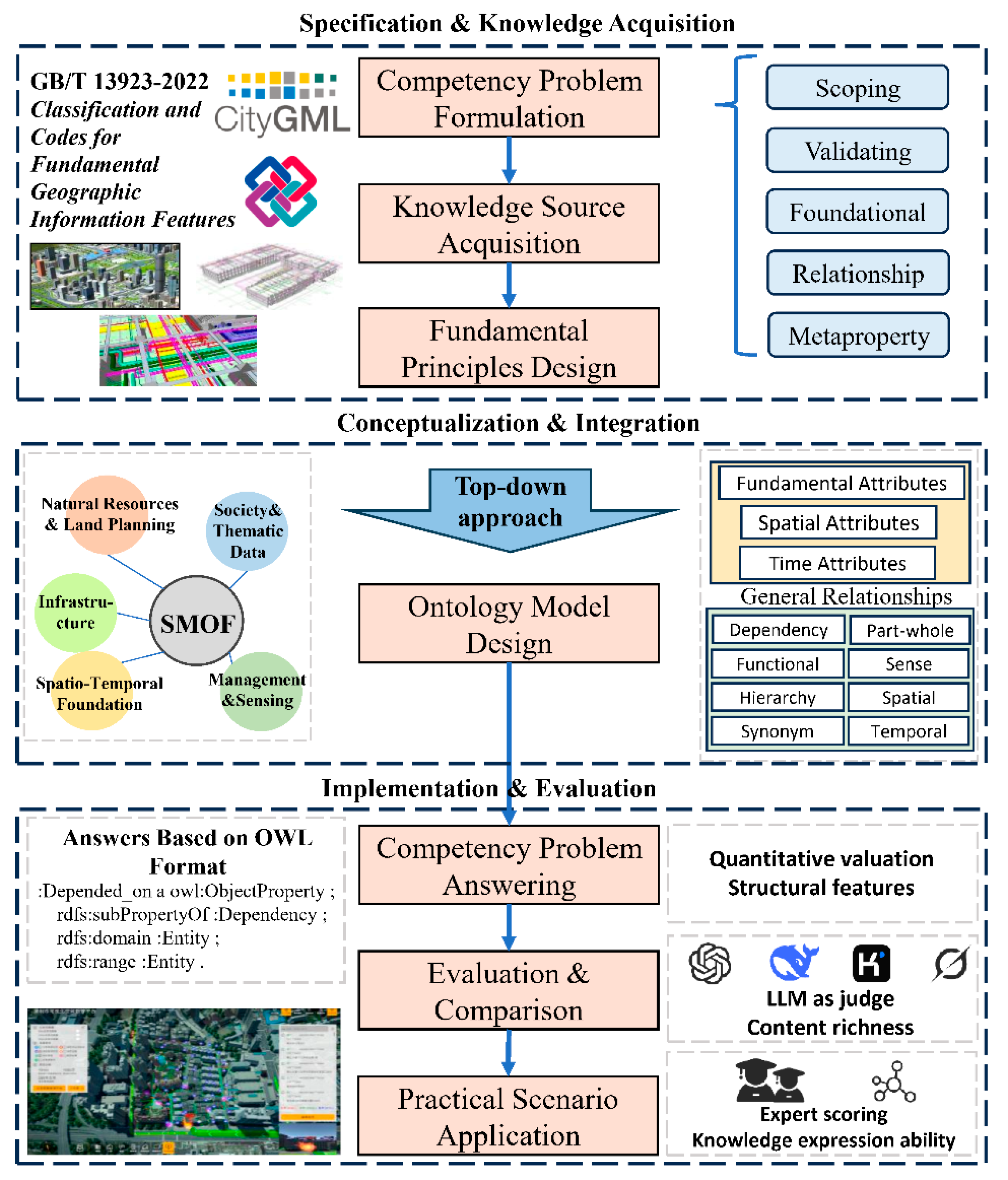


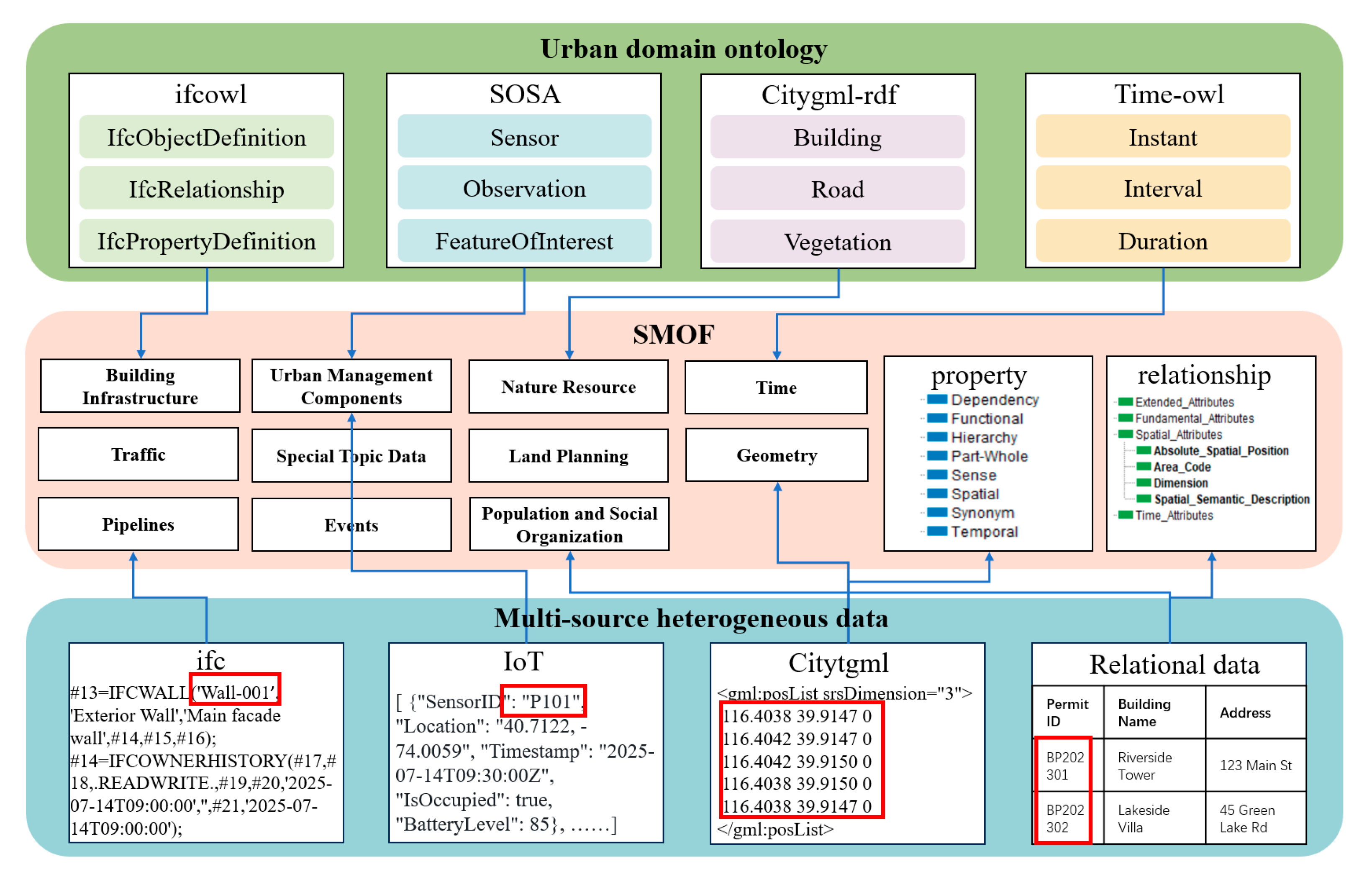
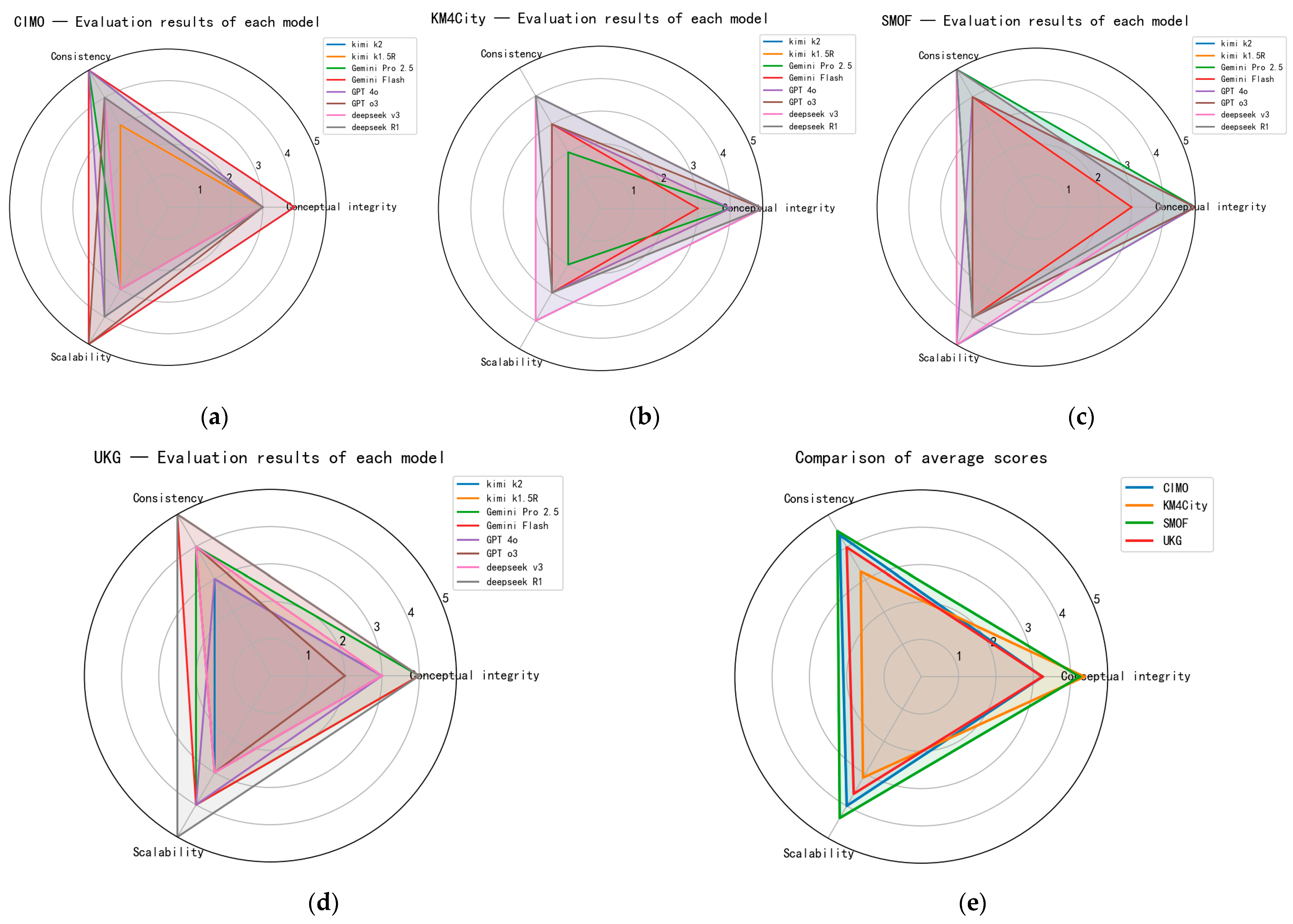
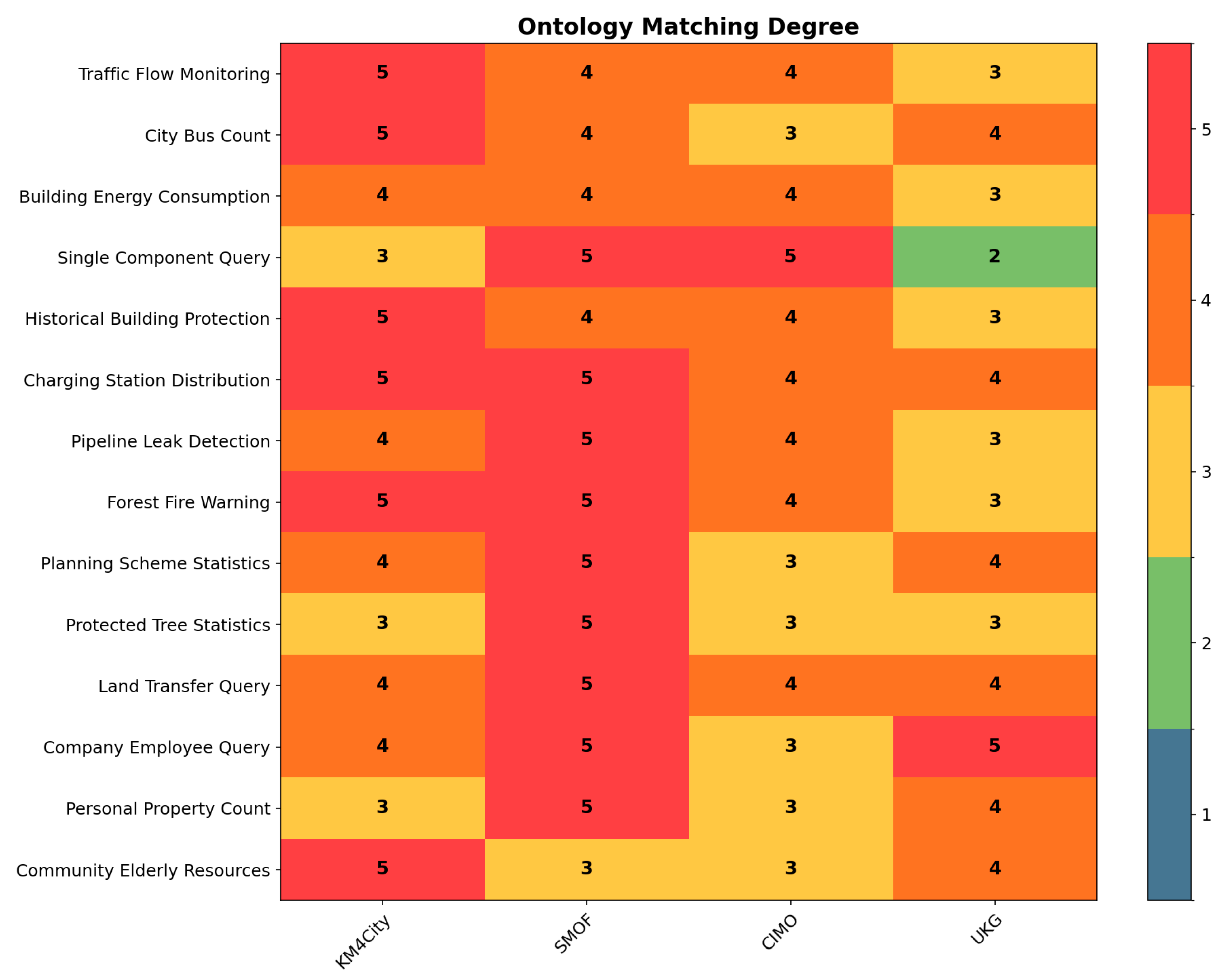
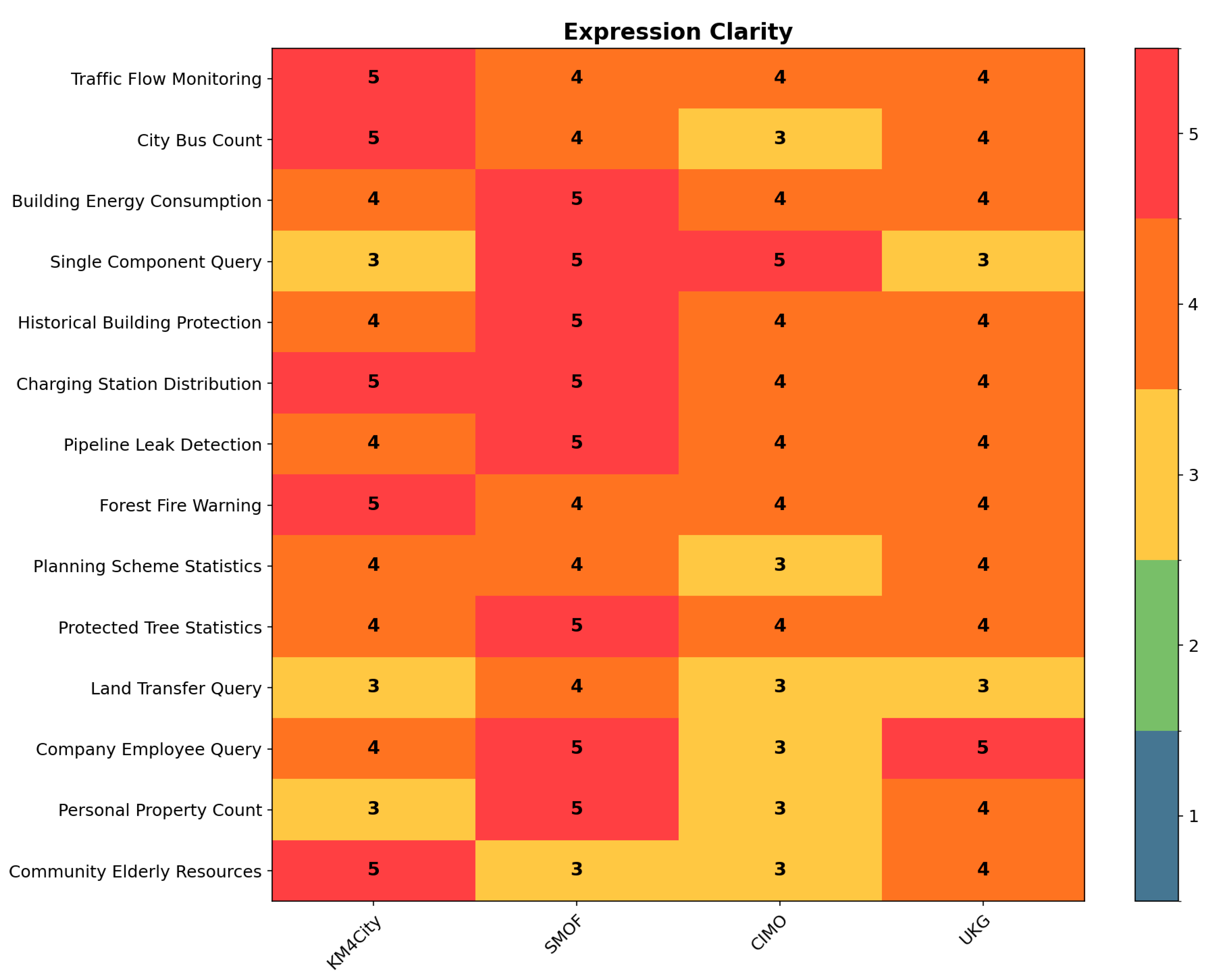
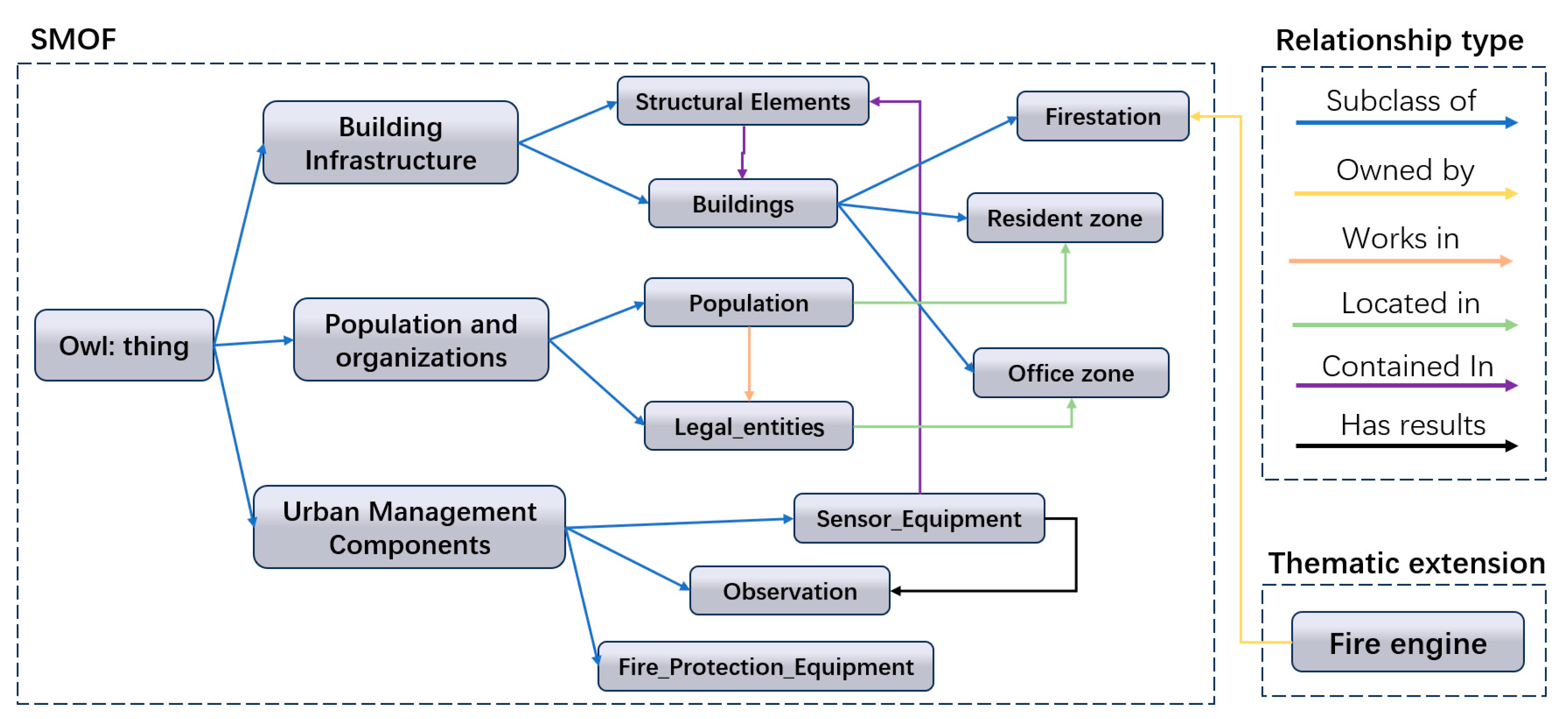
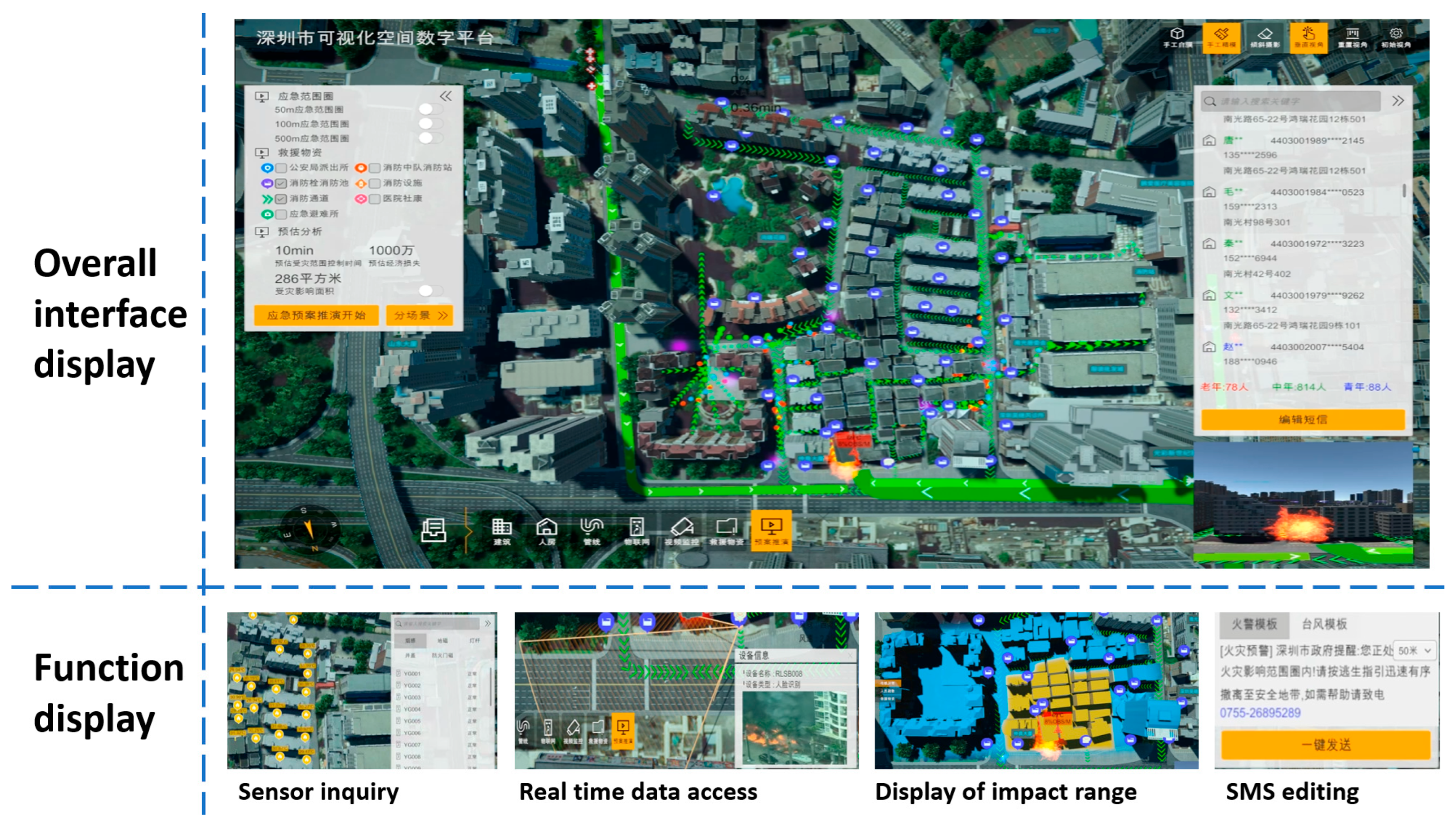

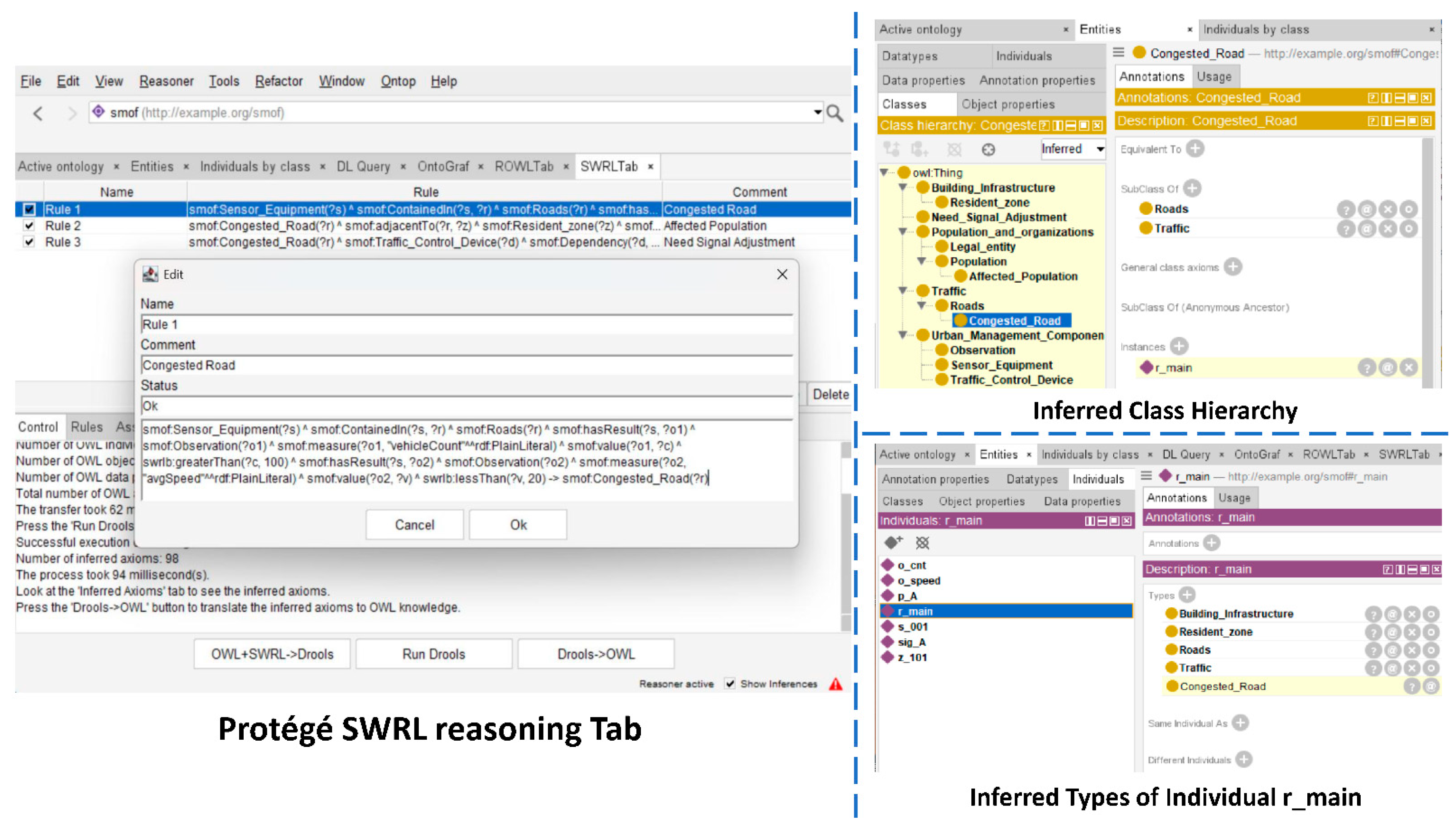
| CQ Category | Purpose | Concrete Question |
|---|---|---|
| Scope-defining | Delimit the thematic range of the ontology | CQ1: Can SMOF represent hierarchical structures among entities, the intrinsic information of each entity, and inter-entity relations? |
| CQ2: Which urban domains can SMOF cover? | ||
| Verification | Validate ontology content | CQ3: Can SMOF encode spatial information in terms of address, latitude–longitude, and topology? |
| CQ4: Can SMOF map to the macro-classes defined in KM4City, UrbanKG, and related ontologies? | ||
| Foundational alignment | Align domain entities with foundational ontologies | CQ5: Can SMOF interoperate with ontologies that capture spatial and geometric information? |
| CQ6: Can SMOF map to sensor-oriented ontologies? | ||
| Relation-oriented | Characterize key relational patterns | CQ7: Can SMOF express basic relations such as whole-part and dependency? |
| CQ8: Can SMOF support semantic reasoning based on the defined relations? | ||
| Meta-attribute | Specify essential attributes | CQ9: Can SMOF represent common attributes such as name and state? |
| CQ10: Can SMOF ensure global identity uniqueness for entities via meta-attributes? |
| Category | Representative Standards/Ontologies | Purpose/Role in Ontology Construction |
|---|---|---|
| Geospatial Standards | GB/T 40765-2021 [40]; GB/T 13923-2022 [41]; CityGML [42]; CJJ/T 197-2018 [43] | Define geographic ontology models, classification codes, and 3D city object schemas |
| Urban Management | GB/T 30428.2-2013 [44]; GB/T 28590-2012 [45]; GB/T 36625.5-2019 [46] | Provide taxonomies and coding for managed components, underground facilities, and municipal infrastructure data |
| Building Information | IFC 4x1 [47]; GB/T 51269-2017 [48] | Standardize BIM information structure and coding |
| Cross-domain Ontologies | KM4City [36]; UrbanKG [35]; SSN/SOSA [49] | Integrate multi-domain municipal, transport, and POI datasets |
| Temporal & Semantic Standards | TimeOWL [50]; GB/T 32853-2016 [51] | Support temporal reasoning and unified geospatial classification |
| Mapping Type | SWRL Rule Example |
|---|---|
| Direct | ifcowl:IfcWindow(?x) → smof:Window(?x) |
| sosa:Observation(?x) → smof:Observation(?x) | |
| Indirect | sosa:Sensor(?x) ∧ sosa:observes(?x,”AirQuality”^^xsd:string) → smof:AirQualitySensor(?x) |
| timeowl:TimeInterval(?x) ∧ timeowl:hasStart(?x,?t1) ∧ timeowl:hasEnd(?x,?t2) ∧ swrlb:greaterThan(?t2,?t1) → smof:ValidInterval(?x) | |
| Attribute/relation | ifcowl:IfcDoor(?x) ∧ ifcowl:Name_Pset_IfcDoor(?x,?n) → smof:Door(?x) ∧ smof:doorName(?x,?n) |
| citygml:Building(?b) ∧ citygml:contains(?b,?r) ∧ citygml:Room(?r) → smof:Building(?b) ∧ smof:containsSpace(?b,?r) |
| Ontology | Attribute Richness | Inheritance Richness | Relationship Richness |
|---|---|---|---|
| KM4City | 0.421 | 1.190 | 0.165 |
| UrbanKG | 8.283 | 0.583 | 0.754 |
| CIMO | 1.850 | 0.986 | 0.131 |
| SMOF | 9.688 | 0.981 | 0.127 |
| Objective | SPARQL Query |
|---|---|
| Find sensors whose temperature reading exceeds 60 °C | SELECT ?sensor WHERE { ?sensor a smof:Sensor_Equipment; smof:hasResult ?observation. ?observation a smof:Observation; smof:measure “°C”; smof:value ?value. FILTER (?value > 60) } |
| Identify the affected structural element and its parent building | SELECT ?structuralElement ?building WHERE { ?sensor a smof:Sensor_Equipment. ?sensor smof:ContainedIn ?structuralElement. ?structuralElement a ?structSubClass. ?structSubClass rdfs:subClassOf smof:StructuralElements. ?structuralElement smof:isPartOf ?building. ?building a ?bldgSubClass. ?bldgSubClass rdfs:subClassOf smof:BuildingTypologies. } |
| Retrieve populations and companies located in the damaged building | SELECT ?populationName ?legalEntityName WHERE { ?building a ?bldgSubClass. ?bldgSubClass rdfs:subClassOf smof:BuildingTypologies. ?population a smof:Population; smof:works_in ?building; smof:Name ?populationName. ?legalEntity a smof:legalEntities; smof:located_in ?building; smof:Name ?legalEntityName. } |
| List fire protection equipment, fire stations and fire truck names within 1 km of the building | SELECT ?fireProtectionEquipment ?firestation ?fireTruckName WHERE { ?building a ?bldgSubClass. ?bldgSubClass rdfs:subClassOf smof:BuildingTypologies. ?building smof:AbsoluteSpatialPosition ?buildingPos. # equipment within 1 km ?fireEquipment a smof:FireProtectionEquipment; smof:AbsoluteSpatialPosition ?fireEqPos. FILTER (geof:distance(?buildingPos, ?fireEqPos) <= 1000) # optional: fire station within 1 km OPTIONAL { ?firestation a smof:Firestation; smof:AbsoluteSpatialPosition ?firestationPos. FILTER (geof:distance(?buildingPos, ?firestationPos) <= 1000) ?firestation smof:ownedBy ?fireTruck. ?fireTruck a smof:FireTruck; smof:Name ?fireTruckName. } } |
| Rule ID | Purpose | SWRL Rule | Results |
|---|---|---|---|
| 1 | Identify congested road segments from sensor observations | smof:Sensor_Equipment(?s) ^ smof:ContainedIn(?s, ?r) ^ smof:Road(?r) ^ smof:hasResult(?s, ?o1) ^ smof:Observation(?o1) ^ smof:measure(?o1, “vehicleCount”^^xsd:string) ^ smof:value(?o1, ?c) ^ swrlb:greaterThan(?c, 100) ^ smof:hasResult(?s, ?o2) ^ smof:Observation(?o2) ^ smof:measure(?o2, “avgSpeed”^^xsd:string) ^ smof:value(?o2, ?v) ^ swrlb:lessThan(?v, 20) -> smof:Congested_Road(?r) | smof:Congested_Road |
| 2 | Propagate road congestion to human impact via spatial context | smof:Congested_Road(?r) ^ smof:adjacentTo(?r, ?z) ^ smof:Resident_zone(?z) ^ smof:Population(?p) ^ smof:located_in(?p, ?z) -> smof:Affected_Population(?p) | smof:Affected_Population |
| 3 | Recommend operational adjustment for dependent devices | smof:Congested_Road(?r) ^ smof:Traffic_Control_Device(?d) ^ smof:Dependency(?d, ?r) -> smof:Need_Signal_Adjustment(?d) | smof:Need_Signal_Adjustment |
Disclaimer/Publisher’s Note: The statements, opinions and data contained in all publications are solely those of the individual author(s) and contributor(s) and not of MDPI and/or the editor(s). MDPI and/or the editor(s) disclaim responsibility for any injury to people or property resulting from any ideas, methods, instructions or products referred to in the content. |
© 2025 by the authors. Licensee MDPI, Basel, Switzerland. This article is an open access article distributed under the terms and conditions of the Creative Commons Attribution (CC BY) license (https://creativecommons.org/licenses/by/4.0/).
Share and Cite
He, X.; Kuai, X.; Li, X.; Qiu, Z.; He, B.; Guo, R. Smart City Ontology Framework for Urban Data Integration and Application. Smart Cities 2025, 8, 165. https://doi.org/10.3390/smartcities8050165
He X, Kuai X, Li X, Qiu Z, He B, Guo R. Smart City Ontology Framework for Urban Data Integration and Application. Smart Cities. 2025; 8(5):165. https://doi.org/10.3390/smartcities8050165
Chicago/Turabian StyleHe, Xiaolong, Xi Kuai, Xinyue Li, Zihao Qiu, Biao He, and Renzhong Guo. 2025. "Smart City Ontology Framework for Urban Data Integration and Application" Smart Cities 8, no. 5: 165. https://doi.org/10.3390/smartcities8050165
APA StyleHe, X., Kuai, X., Li, X., Qiu, Z., He, B., & Guo, R. (2025). Smart City Ontology Framework for Urban Data Integration and Application. Smart Cities, 8(5), 165. https://doi.org/10.3390/smartcities8050165







